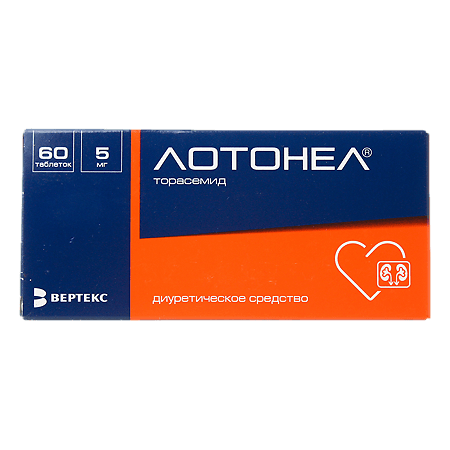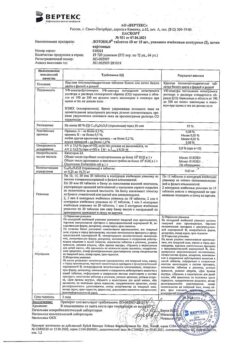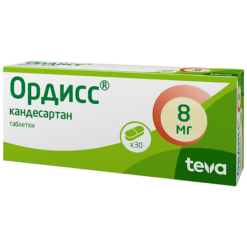No products in the cart.
Lotonel, tablets 5 mg 60 pcs
€17.19 €14.32
Description
Pharmacotherapeutic group
Diuretic agent.
ATX code
C03CA04
Pharmacological properties .
Pharmacodynamics
Thorasemide is a “loop” diuretic. The main mechanism of action of the drug is due to the reversible binding of thorasemide to the sodium/chlorine/potassium ion transporter located in the apical membrane of the thick segment of the ascending loop of Genle, which results in a reduction or complete inhibition of sodium ion reabsorption and a decrease in intracellular fluid osmotic pressure and water reabsorption. Torasemide blocks myocardial aldosterone receptors, reduces fibrosis and improves diastolic function of the myocardium.
Thorasemide causes hypokalemia to a lesser extent than furosemide due to its anti-aldosterone action, but it is more active and its effect is longer.
The diuretic effect develops about an hour after oral administration, reaching a maximum after 2-3 hours, and lasts up to 18 hours, which facilitates tolerance of therapy because there is no very frequent urination in the first hours after oral administration, which limits patient activity.
Torasemide reduces systolic and diastolic blood pressure while lying and standing.
The use of torasemide is the most reasonable choice for long-term therapy.
Pharmacokinetics
absorption
.After oral administration, thoracemide is rapidly and almost completely absorbed in the gastrointestinal tract. Food intake has no significant effect on absorption of the drug. Maximum concentration of thorasemide in blood plasma is noted 1-2 hours after oral administration. Bioavailability is 80-90 % with slight individual variations.
Distribution
The binding to plasma proteins is more than 99 %. The volume of distribution in healthy volunteers and in patients with mild to moderate renal insufficiency or chronic heart failure is 12 to 16 liters. In patients with cirrhosis the volume of distribution is doubled.
Metabolism
Metabolized in the liver by cytochrome P450 system isoenzymes. Sequential oxidation, hydroxylation or ring hydroxylation reactions produce three metabolites (M1, M3 and M5), which bind 86%, 95% and 97% to plasma proteins, respectively.
Elimation
The elimination half-life (T1/2) of torasemide and its metabolites in healthy volunteers is 3-4 hours. Total clearance of torasemide is 40 ml/min, renal clearance – 10 ml/min. On average, about 83% of the taken dose is excreted by the kidneys: unchanged (24%) and as mainly inactive metabolites (M1 – 12%, M3 – 3%, M5 – 41%).
Pharmacokinetics in special groups of patients
In renal failure, the T1/2 torasemide is unchanged, the T1/2 metabolites M3 and M5 are increased. Torasemide and its metabolites are slightly excreted by hemodialysis and hemofiltration.
In hepatic insufficiency, plasma concentration of torasemide is increased due to decreased rate of metabolism of the drug in the liver.
In patients with cardiac or hepatic insufficiency the T1/2 of torasemide and the M5 metabolite are slightly increased and cumulation of the drug is unlikely.
The pharmacokinetic profile of thoracemide in elderly patients is similar to that in younger patients, with the exception that there is a decrease in renal clearance of the drug due to the characteristic age-related impairment of renal function in elderly patients. Total clearance and T1/2 are unchanged.
Indications
Indications
edema syndrome of various origins, including with chronic heart failure, diseases of the liver, lungs and kidneys;
arterial hypertension.
Pharmacological effect
Pharmacological effect
Pharmacotherapeutic group
Diuretic.
ATC code
C03CA04
Pharmacological properties
Pharmacodynamics
Torasemide is a loop diuretic. The main mechanism of action of the drug is due to the reversible binding of torasemide to the sodium/chlorine/potassium ion contransporter located in the apical membrane of the thick segment of the ascending loop of Henle, as a result of which the reabsorption of sodium ions is reduced or completely inhibited and the osmotic pressure of intracellular fluid and water reabsorption are reduced. Torsemide blocks myocardial aldosterone receptors, reduces fibrosis and improves myocardial diastolic function.
Due to its antialdosterone action, torasemide causes hypokalemia to a lesser extent than furosemide, while it is more active and its action lasts longer.
The diuretic effect develops approximately an hour after oral administration, reaching a maximum after 2-3 hours, and lasts up to 18 hours, which facilitates the tolerability of therapy due to the absence of very frequent urination in the first hours after taking the drug orally, which limits the activity of patients.
Torasemide reduces systolic and diastolic blood pressure in the “lying” and “standing” positions.
The use of torasemide is the most reasonable choice for long-term therapy.
Pharmacokinetics
Suction
After oral administration, torasemide is quickly and almost completely absorbed from the gastrointestinal tract. Food intake does not have a significant effect on the absorption of the drug. The maximum concentration of torasemide in the blood plasma is observed 1-2 hours after oral administration. Bioavailability is 80-90% with minor individual variations.
Distribution
More than 99% binding to plasma proteins. The volume of distribution in healthy volunteers and in patients with mild to moderate renal failure or chronic heart failure ranges from 12 to 16 L. In patients with liver cirrhosis, the volume of distribution is doubled.
Metabolism
Metabolized in the liver using isoenzymes of the cytochrome P450 system. As a result of successive reactions of oxidation, hydroxylation or ring hydroxylation, three metabolites are formed (M1, M3 and M5), which bind to plasma proteins by 86%, 95% and 97%, respectively.
Withdrawal
The half-life (T1/2) of torasemide and its metabolites in healthy volunteers is 3-4 hours. The total clearance of torasemide is 40 ml/min, renal clearance is 10 ml/min. On average, about 83% of the dose taken is excreted by the kidneys: unchanged (24%) and in the form of predominantly inactive metabolites (M1 – 12%, M3 – 3%, M5 – 41%).
Pharmacokinetics in special groups of patients
In renal failure, T1/2 of torasemide does not change, T1/2 of metabolites M3 and M5 increases. Torsemide and its metabolites are slightly eliminated by hemodialysis and hemofiltration.
In case of liver failure, the concentration of torasemide in the blood plasma increases due to a decrease in the rate of metabolism of the drug in the liver.
In patients with heart or liver failure, T1/2 of torasemide and the M5 metabolite are slightly increased, drug accumulation is unlikely.
The pharmacokinetic profile of torasemide in elderly patients is similar to that in younger patients, with the exception that there is a decrease in renal clearance of the drug due to the characteristic age-related decline in renal function in elderly patients. The overall clearance and T1/2 do not change.
Special instructions
Special instructions
The drug LOTONEL® is used strictly as prescribed by a doctor.
Patients with hypersensitivity to sulfonamides and sulfonylurea derivatives may have cross-sensitivity to torsemide.
For patients receiving high doses of torasemide for a long period, in order to avoid the development of hyponatremia, hypokalemia and metabolic alkalosis, a diet with sufficient sodium content and the use of drugs are recommended potassium.
The risk of hypokalemia is greatest in patients with liver cirrhosis, increased diuresis, insufficient dietary electrolytes, and concomitant use of corticosteroids or ACTH.
An increased risk of developing fluid and electrolyte imbalances is observed in patients with renal failure. During a course of treatment with LOTONEL®, it is necessary to periodically monitor the content of electrolytes in the blood plasma (including sodium, calcium, potassium, magnesium), the acid-base state, the concentration of residual nitrogen, creatinine, uric acid and, if necessary, carry out appropriate corrective therapy (with a higher frequency in patients with frequent vomiting and against the background of parenteral administration of fluids).
In patients with developed water-electrolyte problems disorders, hypovolemia or prerenal azotemia, laboratory findings may include: hyper- or hyponatremia, hyper- or hypochloremia, hyper- or hypokalemia, acid-base imbalance and increased plasma urea concentrations. If these deviations from laboratory parameters occur, it is necessary to stop taking LOTONEL® until normal values are restored, and then resume treatment with LOTONEL® at a lower dose.
If azotemia and oliguria appear or worsen in patients with severe progressive kidney diseases, it is recommended to suspend treatment with LOTONEL®.
The selection of a dosage regimen for patients with ascites due to liver cirrhosis should be carried out in an inpatient setting. (disturbances in water and electrolyte balance can lead to the development of hepatic coma). This category of patients requires regular monitoring of blood plasma electrolytes.
The use of the drug LOTONEL® may cause an exacerbation of gout.
In patients with diabetes mellitus or with reduced glucose tolerance, periodic monitoring of the concentration of glucose in the blood and urine is required.
In unconscious patients, with benign prostatic hyperplasia, narrowing of the ureters, diuresis control is necessary due to the possibility of acute urinary retention.
In patients with diseases cardiovascular system, especially those taking cardiac glycosides, hypokalemia caused by diuretics can cause the development of arrhythmias.
Influence on the ability to drive vehicles and machinery
During the treatment period, patients should refrain from driving vehicles and engaging in other potentially hazardous activities that require increased concentration and speed of psychomotor reactions (risk of dizziness and drowsiness).
Active ingredient
Active ingredient
Torasemide
Composition
Composition
active ingredient: torasemide – 5.00 mg;
excipients: lactose monohydrate – 75.00 mg; corn starch – 17.50 mg; sodium carboxymethyl starch (sodium starch glycolate, type A) – 1.00 mg; colloidal silicon dioxide – 0.75 mg; magnesium stearate – 0.75 mg.
Pregnancy
Pregnancy
Torsemide does not have a teratogenic effect or fetotoxicity; it penetrates the placental barrier, causing disturbances in water-electrolyte metabolism and thrombocytopenia in the fetus.
There have been no controlled studies on the use of torasemide in pregnant women; the drug is not recommended for use during pregnancy.
There is no data on the excretion of torasemide into breast milk, therefore, if it is necessary to use torasemide during lactation, breastfeeding should be stopped.
Contraindications
Contraindications
hypersensitivity to torsemide or to any of the components of the drug;
allergy to sulfonamides (sulfonamide antimicrobials or sulfonylureas);
renal failure with anuria;
hepatic coma and precoma;
refractory hypokalemia;
refractory hyponatremia;
hypovolemia (with or without arterial hypotension) or dehydration;
pronounced disturbances in the outflow of urine of any etiology (including unilateral damage to the urinary tract);
glycoside intoxication;
acute glomerulonephritis;
sinoatrial and atrioventricular blockade of II-III degree;
decompensated aortic and mitral stenosis;
hypertrophic obstructive cardiomyopathy;
increased central venous pressure (over 10 mm Hg);
arrhythmia;
chronic renal failure with increasing azotemia;
hyperuricemia;
age under 18 years (safety and effectiveness have not been established);
pregnancy;
breastfeeding period;
simultaneous use of aminoglycosides and cephalosporins;
lactose intolerance, lactase deficiency or glucose-galactose malabsorption.
With caution
arterial hypotension;
stenosing atherosclerosis of cerebral arteries;
hypoproteinemia;
disturbances in the outflow of urine (benign prostatic hyperplasia, narrowing of the urethra or hydronephrosis);
history of ventricular arrhythmia;
acute myocardial infarction (increased risk of developing cardiogenic shock);
diarrhea;
pancreatitis;
hypokalemia;
hyponatremia;
liver dysfunction, liver cirrhosis, renal failure, hepatorenal syndrome;
diabetes mellitus (decreased glucose tolerance);
gout, predisposition to hyperuricemia;
anemia;
simultaneous use of cardiac glycosides, corticosteroids and adrenocorticotropic hormone (ACTH).
Side Effects
Side Effects
The incidence of side effects is classified according to the recommendations of the World Health Organization:
very common: ≥ 1/10 (˃ 10%);
often: from ≥ 1/100 to ˂ 1/10 (˃ 1% and ˂ 10%)
uncommon: from ≥ 1/1000 to ˂ 1/100 (˃ 0.1% and ˂ 1%)
rare: from ≥ 1/10000 to ˂ 1/1000 (˃ 0.01% and ˂ 0.1%)
very rare: ˂ 1/10000 (˂ 0.01%)
frequency unknown: frequency cannot be estimated from available data.
Blood and lymphatic system disorders:
frequency unknown – thrombocytopenia, leukopenia, agranulocytosis, aplastic or hemolytic anemia.
Immune system disorders:
severe anaphylactic reactions up to shock, which until now have only been described after intravenous administration.
Metabolic and nutritional disorders:
uncommon – polydipsia;
frequency unknown – hypokalemia, hyponatremia, hypomagnesemia, hypocalcemia, hypochloremia, metabolic alkalosis, hypovolemia, dehydration (more often in elderly patients), which can lead to hemoconcentration with a tendency to develop blood clots).
Nervous system disorders:
often – headache, dizziness, drowsiness;
uncommon – muscle cramps of the lower extremities;
frequency unknown – confusion, fainting, paresthesia in the extremities (feeling of numbness, crawling and tingling).
Vision disorders:
frequency unknown – visual impairment.
Disorders of the hearing organ and labyrinth:
frequency unknown – hearing impairment, tinnitus and hearing loss (usually reversible), usually in patients with renal failure or hypoproteinemia (nephrotic syndrome).
Heart disorders:
uncommon – extrasystole, arrhythmia, tachycardia, increased heart rate.
Vascular disorders:
frequency unknown – excessive decrease in blood pressure, orthostatic hypotension, collapse, deep vein thrombosis, thromboembolism, decrease in circulating blood volume.
Disorders of the respiratory system, chest and mediastinal organs:
uncommon – nosebleeds.
Gastrointestinal disorders:
often – diarrhea;
uncommon – abdominal pain, flatulence;
frequency unknown – dry mouth, nausea, vomiting, loss of appetite, pancreatitis, dyspeptic disorders.
Disorders of the liver and biliary tract:
frequency unknown – intrahepatic cholestasis.
Skin and subcutaneous tissue disorders:
uncommon – redness of the face;
frequency unknown – skin itching, rash, urticaria, erythema multiforme, exfoliative dermatitis, purpura, vasculitis, photosensitivity.
Muscular, skeletal and connective tissue disorders:
frequency unknown – muscle weakness.
Disorders of the kidneys and urinary tract:
often – increased frequency of urination, polyuria, nocturia;
uncommon – frequent urge to urinate;
frequency unknown – oliguria, urinary retention (in patients with urinary tract obstruction), interstitial nephritis, hematuria.
Disorders of the reproductive system and mammary glands:
frequency unknown – decreased potency.
General disorders and reactions at the injection site:
uncommon – fever, asthenia, weakness, fatigue, hyperactivity, nervousness.
Laboratory and instrumental data:
uncommon – hypercholesterolemia, hypertriglyceridemia;
frequency unknown – hyperuricemia, a slight increase in the activity of alkaline phosphatase in the blood plasma, an increase in the concentration of creatinine and urea in the blood plasma, an increase in the activity of some “liver” enzymes in the blood plasma (for example, gamma-glutamyltransferase), hyperglycemia, decreased glucose tolerance (possible manifestation of latent diabetes mellitus).
If any of the side effects indicated in the instructions get worse or you notice any other side effects not listed in the instructions, tell your doctor.
Interaction
Interaction
With simultaneous use of torasemide with mineralo- and glucocorticosteroids, amphotericin B, the risk of developing hypokalemia increases; with cardiac glycosides – the risk of developing glycoside intoxication increases due to hypokalemia (for high- and low-polarity cardiac glycosides) and prolongation of the half-life (for low-polarity cardiac glycosides).
Taking torsemide increases the concentration and risk of developing nephro- and ototoxic effects of cephalosporins, aminoglycosides, chloramphenicol, ethacrynic acid, antibiotics, salicylates, cisplatin, platinum drugs, amphotericin B (due to competitive renal excretion).
Sequential or simultaneous use of torasemide with angiotensin-converting enzyme (ACE) inhibitors or angiotensin II receptor antagonists can lead to a sharp decrease in blood pressure. This can be avoided by reducing the initial dose of the ACE inhibitor or reducing the dose of torasemide (or temporarily stopping it).
Non-steroidal anti-inflammatory drugs, sucralfate, reduce the diuretic effect of torasemide due to inhibition of prostaglandin synthesis, disruption of renin activity in the blood plasma and aldosterone excretion.
Torasemide enhances the antihypertensive effect of antihypertensive drugs, neuromuscular blockade of depolarizing muscle relaxants (suxamethonium) and weakens the effect of non-depolarizing muscle relaxants (tubocurarine).
Torasemide reduces the renal clearance of lithium drugs and increases the likelihood of intoxication.
Torasemide increases the effectiveness of diazoxide and theophylline, reduces the effectiveness of hypoglycemic agents, allopurinol.
Pressor amines and torasemide mutually reduce each other’s effectiveness.
Drugs that block tubular secretion increase the concentration of torasemide in the blood plasma.
With simultaneous use of cyclosporine and torasemide, the risk of developing gouty arthritis increases due to the fact that cyclosporine can cause impaired urate excretion by the kidneys, and torasemide can cause hyperuricemia.
Concomitant use of probenecid or methotrexate may reduce the effectiveness of torsemide (same secretion route). On the other hand, torasemide may lead to decreased renal elimination of these drugs.
It has been reported that in patients at high risk of developing nephropathy taking torasemide orally, renal dysfunction was observed more frequently when radiocontrast agents were administered than in patients at high risk of developing nephropathy who received intravenous hydration before administration of radiocontrast agents.
Bioavailability and, as a result, the effectiveness of torasemide may be reduced when combined with cholestyramine.
Overdose
Overdose
Symptoms
Increased diuresis, accompanied by a decrease in circulating blood volume and disturbance of the water-electrolyte balance of the blood, followed by a pronounced decrease in blood pressure, drowsiness and confusion, collapse. Gastrointestinal disturbances may occur.
Treatment
There is no specific antidote. Provocation of vomiting, gastric lavage, activated charcoal. Treatment is symptomatic, dose reduction or discontinuation of the drug and at the same time replenishment of circulating blood volume and correction of water-electrolyte balance and acid-base status under the control of the content of electrolytes in the blood plasma and hematocrit level. Hemodialysis is ineffective, since the elimination of torasemide and its metabolites is not accelerated.
Storage conditions
Storage conditions
Store in a place protected from light at a temperature not exceeding 25 ºС.
Keep out of the reach of children.
Shelf life
Shelf life
3 years.
Do not use after expiration date.
Manufacturer
Manufacturer
Vertex, Russia
Additional information
| Shelf life | 3 years. Do not use after the expiration date. |
|---|---|
| Conditions of storage | Store in a light-protected place at a temperature not exceeding 25 ºC. Keep out of reach of children. |
| Manufacturer | Vertex, Russia |
| Medication form | pills |
| Brand | Vertex |
Other forms…
Related products
Buy Lotonel, tablets 5 mg 60 pcs with delivery to USA, UK, Europe and over 120 other countries.


















